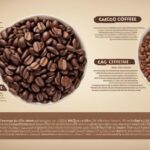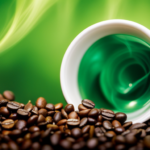Raw Food Ingredients
Cacao Vs Coffee: Caffeine Showdown
Uncover the surprising differences between cacao and coffee in this caffeine showdown, and discover which one suits your energy needs best.
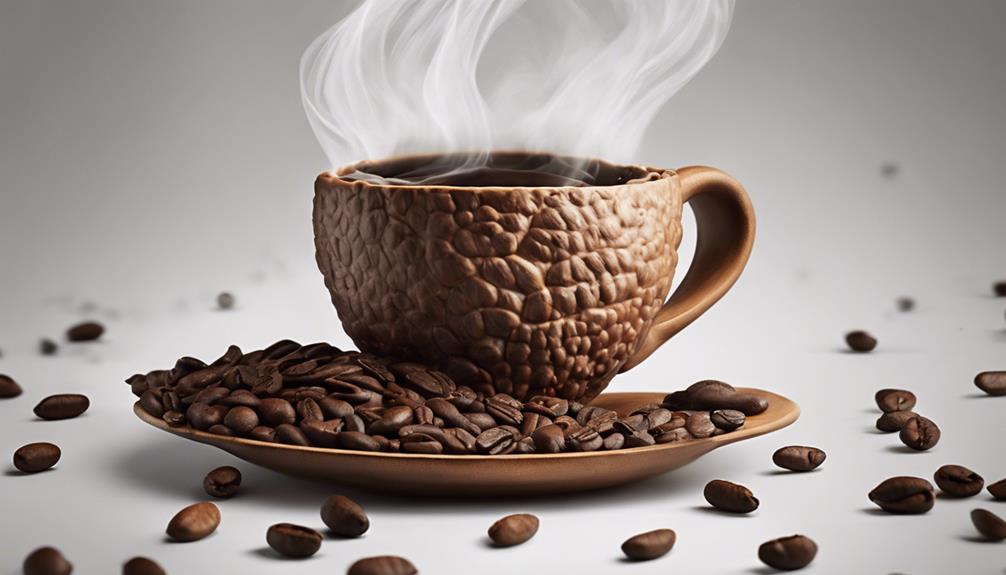
When comparing cacao and coffee in terms of caffeine content, it is important to note that coffee contains approximately 95 mg of caffeine per cup, providing a rapid energy boost, whereas cacao offers 12-26 mg per serving with a slower absorption rate. The decision between these beverages depends on individual energy requirements and preferences. Cacao is a good source of antioxidants that promote heart health, whereas coffee contains nutrients such as potassium and niacin. The theobromine found in cacao offers a gentle, sustained energy lift compared to the quick, intense energy spike from caffeine in coffee. Recognizing these distinctions can help in making informed decisions based on energy needs and health advantages.
Key Takeaways
- Coffee has higher caffeine content (95 mg per cup) compared to cacao (12-26 mg per serving).
- Cacao offers a slower absorption rate of caffeine, providing a gentler energy lift.
- Individual energy needs and preferences determine whether to choose cacao or coffee.
- Cacao's theobromine provides sustained energy, while coffee offers quick, intense energy.
- Understanding caffeine differences helps in selecting between cacao and coffee for energy requirements.
Caffeine Content Comparison
When comparing the caffeine content between cacao and coffee, it's apparent that coffee typically contains much higher levels of caffeine per serving. While coffee packs around 95 mg of caffeine in a single cup, cacao only offers a modest 12-26 mg per serving. This significant difference means that if you're looking for a quick energy boost, reaching for a cup of coffee might be more effective due to its higher caffeine content.
Understanding the caffeine content in cacao and coffee is important when deciding which one to choose for that much-needed pick-me-up. The faster absorption rate of caffeine in coffee means that it can provide a quicker energy surge compared to cacao. So, if you need a sudden burst of energy, a cup of coffee might be the way to go. However, if you prefer a milder energy lift or are more sensitive to caffeine, cacao could be a suitable alternative. It's all about knowing what works best for your body and energy needs.
Health Benefits Analysis
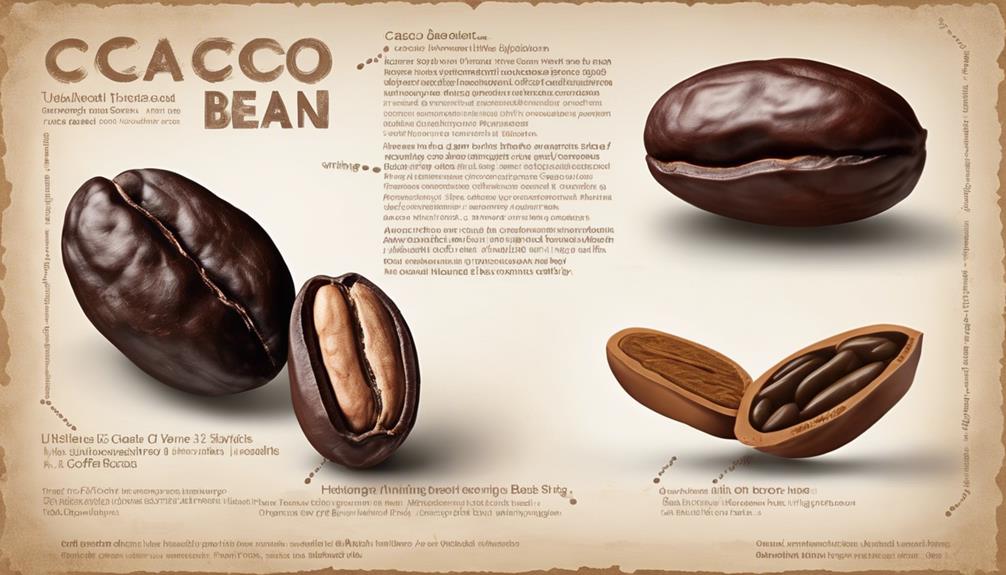
Let's now compare the nutrient content of cacao and coffee to understand their impact on our metabolism.
By analyzing their health benefits, we can see how these two beverages affect our bodies differently.
Understanding these aspects can help us make informed choices about incorporating cacao and coffee into our diets for overall well-being.
Nutrient Content Comparison
Comparing the nutrient content of cacao and coffee reveals distinct health benefits associated with each. Here's a breakdown to help you understand the differences:
- Antioxidants: Cacao is rich in antioxidants, which support heart health and mood enhancement.
- Minerals: Cacao contains minerals like magnesium and iron, while coffee provides nutrients like potassium and niacin.
- Energy: Theobromine in cacao offers a gentle energy lift, while coffee's caffeine content provides a quick energy boost.
- Overall Wellness: Both cacao and coffee offer wellness benefits beyond indulgence, making them valuable additions to a balanced diet.
Understanding these differences can help you make informed choices about which beverage aligns best with your health goals.
Impact on Metabolism
Cacao and coffee both play a significant role in impacting metabolism through their respective stimulant properties. Cacao contains theobromine, which stimulates the central nervous system and enhances blood flow, leading to a boost in metabolism. On the other hand, coffee's caffeine content can also increase metabolism and energy expenditure. Below is a comparison table showcasing the impact of cacao and coffee on metabolism:
| Cacao | Coffee |
|---|---|
| Theobromine in cacao stimulates the central nervous system and improves blood flow, boosting metabolism. | Caffeine in coffee enhances metabolism, aiding in calorie burning and fat oxidation. |
| Provides sustained energy lift without rapid spikes and crashes associated with caffeine. | May temporarily boost metabolic rate, leading to increased energy expenditure. |
Both cacao and coffee can positively influence metabolism, but individual responses may vary based on sensitivity to caffeine and theobromine.
Theobromine Vs. Caffeine
Theobromine and caffeine are two compounds that affect the body in distinct ways.
While caffeine provides a quick, intense energy boost, theobromine offers a more sustained effect without the jittery feeling.
Understanding their differences and effects on the body can help us choose between cacao and coffee for our daily pick-me-up.
Chemical Differences Explained
Exploring the chemical disparities between theobromine and caffeine reveals distinct effects on the body's energy levels. Here's a breakdown to help you understand the differences between these two compounds:
- Theobromine, present in cacao beans, provides a sustained and milder energy boost compared to caffeine.
- Theobromine acts as a vasodilator, widening blood vessels to enhance blood flow throughout the body.
- Coffee contains around 280 mg of caffeine per 250ml serving, while cacao has approximately 43.5 mg per 15g serving.
- Theobromine, named after Theobroma Cacao, offers a gentle pick-me-up, contrasting with the powerful caffeine kick you get from coffee.
Understanding these distinctions can help you choose between cacao and coffee for your daily energy needs.
Effects on Body
Comparing the effects on the body between theobromine and caffeine reveals distinct differences in how they impact energy levels and bodily functions. While caffeine provides a quick and intense energy boost, theobromine in cocoa offers a more sustained and gentle lift without the jitters. Caffeine stimulates the central nervous system, increasing alertness, while theobromine acts as a vasodilator, enhancing blood flow. Here's a comparison table to illustrate the differences:
| Criteria | Theobromine (Cocoa) | Caffeine (Coffee) |
|---|---|---|
| Energy Boost | Sustained and gentle | Quick and intense |
| Impact on CNS | Acts as a vasodilator | Stimulates CNS |
| Caffeine Content | Approximately 43.5mg per 15g | 280mg per 250ml |
Opting for cocoa over coffee can reduce overall caffeine intake while still providing a healthful energy lift.
Health Benefits Compared
Enhancing overall well-being, both cacao and coffee offer distinct health benefits beyond just their caffeine content. When comparing theobromine in dark chocolate to caffeine in coffee, here's what stands out:
- Theobromine in cacao supports heart health and mood enhancement, promoting a sense of well-being.
- Caffeine in coffee enhances cognitive function and physical performance, aiding in focus and alertness.
- Theobromine provides a smooth energy lift without jitters, offering sustained vitality.
- Caffeine offers quick energy but may lead to insomnia with excess consumption, affecting sleep quality.
Understanding these differences can help you choose between the two based on your health goals and lifestyle preferences.
Energy Boost Potential

When it comes to providing an energy boost, cacao and coffee offer distinct levels of caffeine content. Cacao, in the form of chocolate, provides a milder energy lift compared to coffee. A 15g serving of cacao contains approximately 43.5 mg of caffeine, offering a gentle and sustained alertness due to its theobromine content.
On the other hand, coffee delivers a stronger jolt of energy with around 280 mg of caffeine per 250ml serving. The caffeine in coffee acts as a quick stimulant, providing an instant boost of energy. While cacao's theobromine stimulates the central nervous system for prolonged alertness, coffee's caffeine gives a rapid energy surge.
Antioxidants and Minerals Overview
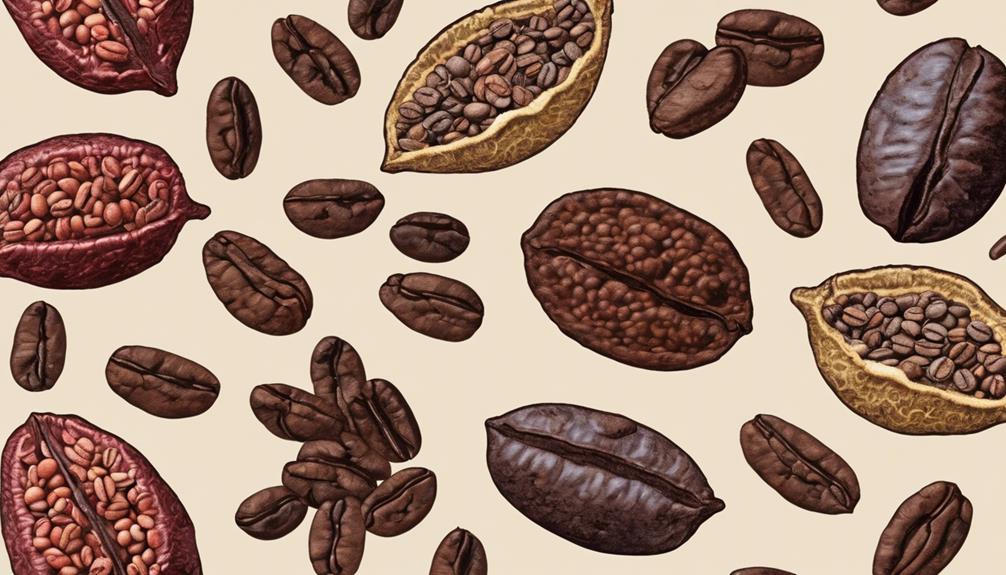
Cacao and coffee both offer a variety of antioxidants and minerals that contribute to overall health and well-being. Here's a breakdown of the key antioxidants and minerals found in these popular beverages:
- Antioxidants in Cacao: Cacao is packed with antioxidants, particularly flavonoids. These compounds are beneficial for heart health and can help reduce inflammation in the body.
- Nutrients in Coffee: Coffee is a good source of essential nutrients like riboflavin, niacin, and potassium. These nutrients play an essential role in maintaining overall health and well-being.
- Minerals in Cacao: Cacao also contains essential minerals such as iron, magnesium, and calcium. These minerals are crucial for various bodily functions, including muscle function and bone health.
- Health Benefits of Coffee: Studies have shown that coffee consumption is linked to a lower risk of type 2 diabetes. This showcases the potential health benefits of incorporating coffee into your diet for its antioxidants and minerals.
Performance and Metabolism Effects

With its ability to provide a sustained energy boost without the typical caffeine jitters, cacao's theobromine offers a unique advantage in enhancing performance and metabolism. Cacao benefits from providing a longer-lasting lift without the sudden crash that can come with coffee consumption. The theobromine in cacao aids in improving blood flow, which can enhance physical performance during activities like workouts or sports. On the other hand, coffee's caffeine is quickly absorbed, offering a rapid energy spike that can be beneficial for short bursts of activity. However, the gentler and longer-lasting energy lift from cacao can be advantageous for sustained efforts over time, providing a more consistent source of energy without the fluctuations associated with coffee. Consider the table below for a quick comparison between cacao and coffee regarding their performance and metabolism effects:
| Aspect | Cacao | Coffee |
|---|---|---|
| Energy Boost | Sustained without jitters | Quick spike |
| Performance | Enhances with improved blood flow | Enhances through rapid absorption |
| Metabolism | Supports longer-lasting energy | Provides rapid boost |
Heart Health Considerations
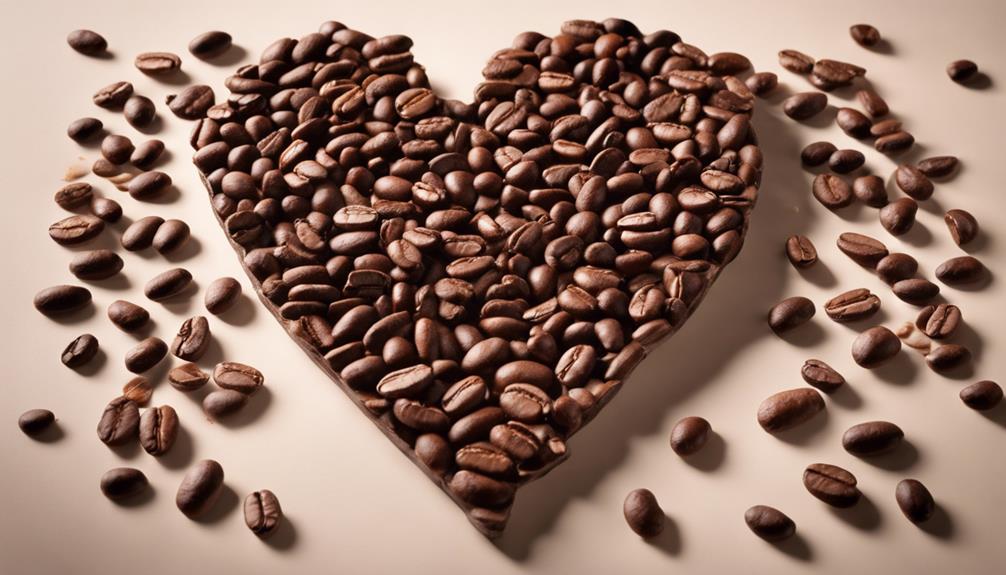
Taking into account the impact on heart health, it's essential to explore the benefits of incorporating both cacao and coffee into a balanced diet. Here are some key points to ponder:
- Theobromine in Cacao: Cacao contains theobromine, which supports heart health by enhancing blood flow and acting as a vasodilator, helping to relax blood vessels and lower blood pressure.
- Reduced Risk: Coffee consumption has been linked to a reduced risk of heart disease and type 2 diabetes, partly due to its protective effects on cardiovascular health.
- Antioxidants: Both cacao and coffee are rich in antioxidants, which play a vital role in protecting the heart from damage caused by harmful free radicals.
- Moderation is Key: Enjoying moderate amounts of cacao and coffee as part of a balanced diet can contribute positively to overall heart health and well-being, providing a tasty way to support a healthy heart.
Mood Enhancement and Stress Relief
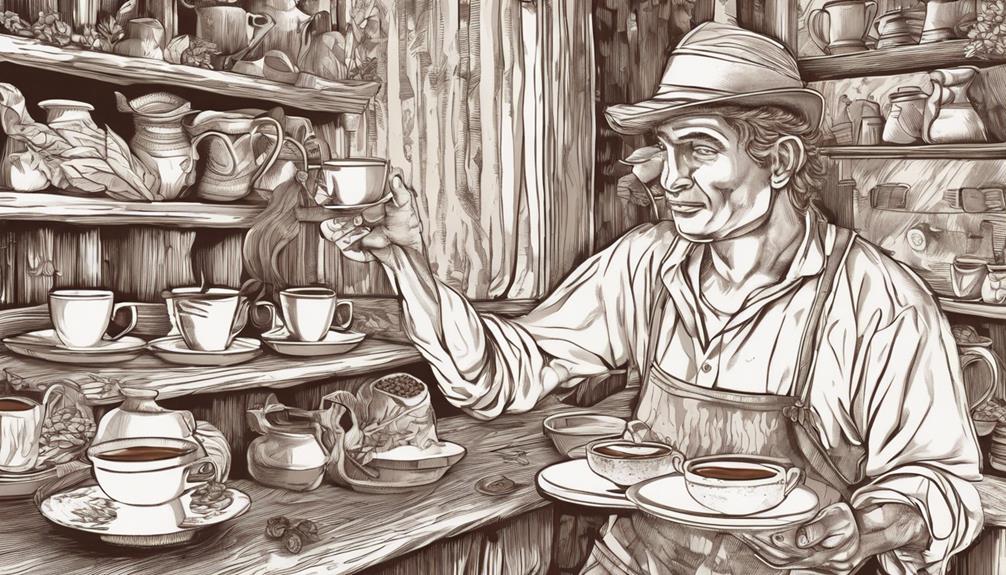
Exploring the impact of cacao and coffee on mood enhancement and stress relief reveals intriguing insights into their potential benefits for mental well-being. Cacao contains theobromine, which is known to promote mood enhancement and stress relief. This compound can help you stay focused and calm, providing a gentle lift in energy levels.
On the other hand, coffee consumption has also been linked to improved mood and reduced stress. The quick boost from coffee can positively impact your mood, offering a different kind of energy lift compared to cacao. Both cacao and coffee present promising opportunities for managing stress levels and enhancing overall well-being.
Whether you prefer the soothing effects of cacao or the energizing jolt from coffee, incorporating these beverages mindfully into your routine can contribute to a more balanced and uplifted mood. So, next time you reach for a cup of cacao or coffee, savor not just the taste but also the potential mood-enhancing benefits they bring.
Anti-inflammatory Properties Evaluation
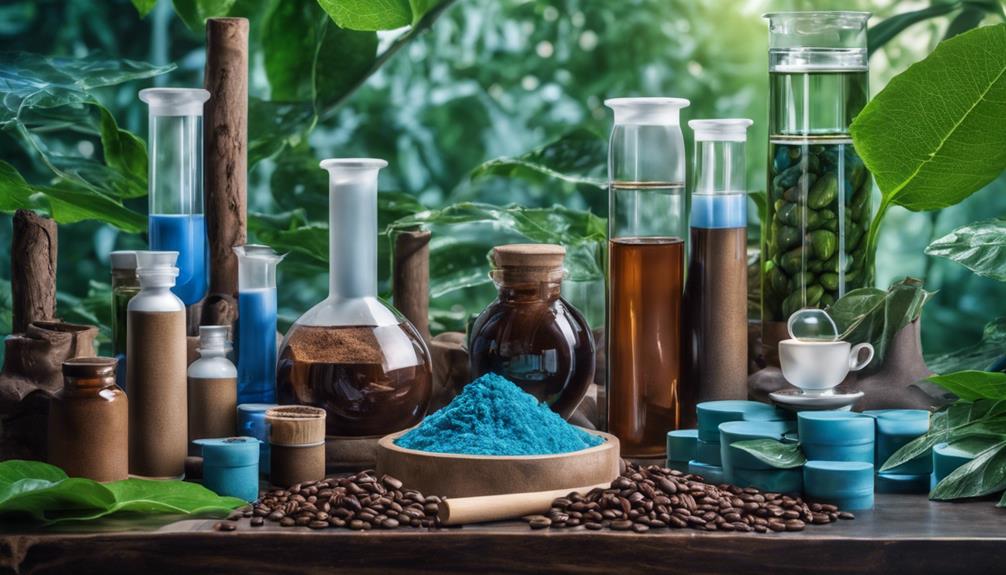
Cacao's flavonoids and coffee's compounds both showcase anti-inflammatory properties, potentially offering health benefits through reducing inflammation in the body.
Here's how the consumption of cacao and coffee can help combat inflammation:
- Flavonoids in Cacao: The flavonoids found in cacao can help reduce inflammation, which may be beneficial for conditions like arthritis and heart disease.
- Compounds in Coffee: Coffee contains compounds that have anti-inflammatory effects, contributing to an overall healthy inflammatory response in the body.
- Antioxidants in Both: Both cacao and coffee are rich in antioxidants, which play a role in combating inflammation-related issues.
- Moderation is Key: Enjoying cacao and coffee in moderation as part of a balanced diet can support an anti-inflammatory diet, potentially benefiting your overall health.
Frequently Asked Questions
Is There More Caffeine in Cacao Than Coffee?
There's actually more caffeine in coffee than cacao. Coffee packs a punch with around 280 mg per serving, while cacao is milder at about 43.5 mg. Opting for cacao over coffee can offer a gentler energy boost.
How Much Caffeine Is in Ceremonial Cacao Vs Coffee?
In ceremonial cacao, there's about 12-26 mg of caffeine per serving, while coffee packs around 95 mg per cup. Choosing cacao offers a gentler caffeine boost compared to coffee, providing balanced energy without the intensity.
How Much Caffeine Is in 70 Percent Cacao?
In a 70 percent cacao dark chocolate bar, there are typically around 25-38 mg of caffeine per 40g serving. It's a delightful way to enjoy a hint of caffeine and savor the benefits of cacao.
Is Cocoa a Stimulant Like Caffeine?
Cocoa, like caffeine, contains theobromine, a milder stimulant. Theobromine in cocoa offers a gentle energy lift without the jitters of caffeine. It acts as a vasodilator, improving blood flow and providing sustained energy.
What are the main differences in caffeine content between cacao and coffee?
When comparing coffee vs cocoa beans differences, it’s important to note that cacao beans contain minimal amounts of caffeine, around 12-20 milligrams per 100 gram serving. In contrast, coffee beans are much higher in caffeine, containing 40-180 milligrams per 100 gram serving.
Conclusion
To sum up, while both cacao and coffee contain caffeine, cacao actually has more theobromine, which can provide a smoother energy boost without the jitters.
Surprisingly, cacao has over 40 times the antioxidants of blueberries, making it a powerful superfood for overall health.
Consider incorporating cacao into your diet for a delicious and nutritious alternative to coffee.
Rachael, the Editor in Chief of RachaelsRawFood.com, is an inspiring and passionate individual who has dedicated her life to promoting the benefits of a raw food lifestyle. Known for her vibrant and energetic personality, Rachael has built a strong online presence that has transformed her personal journey into a thriving community of raw food enthusiasts.
Raw Food Ingredients
Tempered Vs Untempered Chocolate: 10 Key Differences
Get ready to elevate your chocolate-making skills with a deep dive into the key differences between tempered and untempered chocolate – the secret to perfecting your sweet creations!
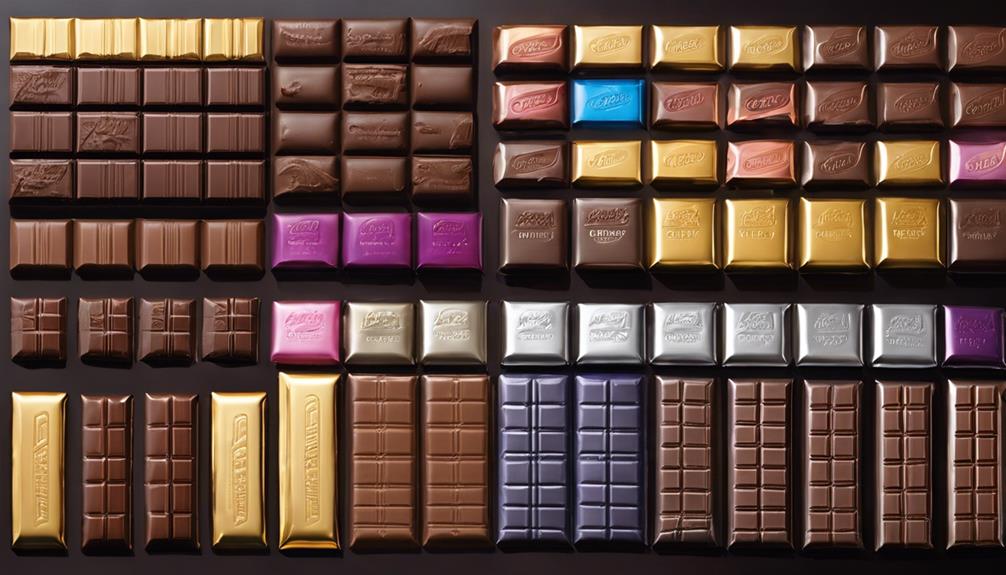
When working with chocolate, it is crucial to comprehend the distinctions between tempered and untempered chocolate. Tempered chocolate is subjected to exact heating and cooling processes, which ultimately yield a glossy finish, firm texture, and satisfying snap. This technique aligns cocoa butter crystals, resulting in a professional appearance and smooth texture. On the other hand, untempered chocolate lacks glossiness and tends to be soft and chalky.
Tempered chocolate remains stable at room temperature due to its resistant crystal structure, making it ideal for coating, molding, and enhancing taste. The glossy finish of tempered chocolate signifies proper crystallization and enhances both appearance and taste, providing a polished and elegant look. Tempered chocolate also melts smoothly, ensuring a clean and consistent flavor profile. Understanding these distinctions is crucial for creating high-quality chocolate treats that look and taste impeccable.
Key Takeaways
- Tempered chocolate has a glossy finish and firm texture.
- Untempered chocolate lacks shine and has a soft, chalky mouthfeel.
- Proper cocoa butter crystal alignment ensures smooth texture.
- Tempered chocolate is stable, resistant to heat-induced melting.
- Taste quality enhanced in tempered chocolate due to proper crystallization.
Definition of Tempered Chocolate
Tempered chocolate, sometimes referred to as 'prepared chocolate,' is a meticulously processed form of chocolate that undergoes precise heating and cooling to achieve specific characteristics. When you temper chocolate, you're fundamentally controlling the formation of cocoa butter crystals within the chocolate.
This process involves heating the chocolate to a specific temperature, then cooling it down and reheating it to another precise temperature. By following these temperature changes, you encourage the cocoa butter in the chocolate to form stable crystals, which give tempered chocolate its glossy finish, firm texture, and that satisfying snap when you break it.
This careful tempering process is essential because it guarantees that the chocolate sets properly and maintains its shape at room temperature. Commercially produced chocolates often undergo this tempering process to achieve the desired quality and appearance that we all enjoy when biting into a delicious piece of chocolate.
Cocoa Butter Crystal Alignment
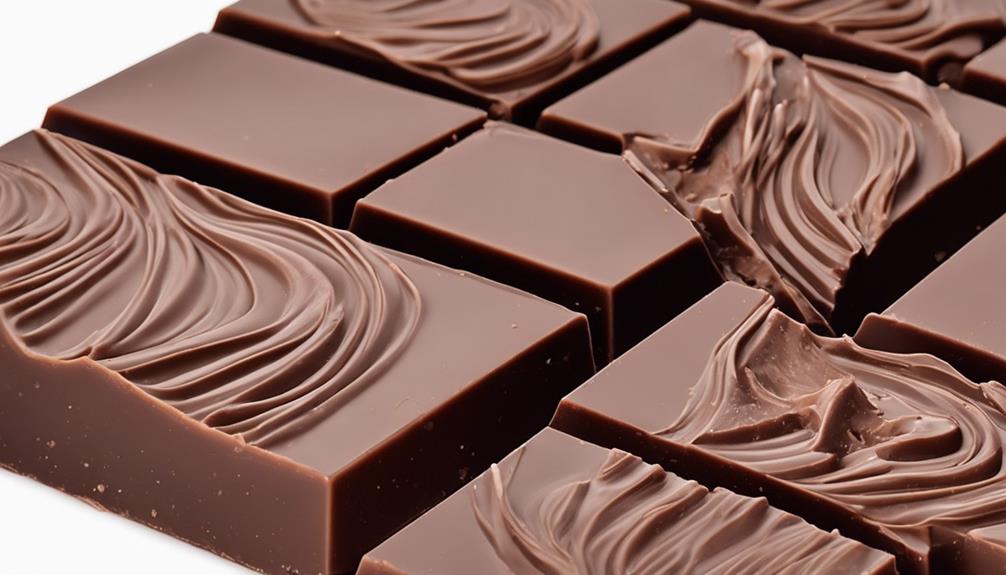
When discussing cocoa butter crystal alignment in chocolate, we're referring to how the cocoa butter molecules arrange themselves during the cooling process.
This alignment is vital because it impacts the overall texture and appearance of the chocolate.
Understanding how these crystals form, the structure of cocoa butter, and their effect on the chocolate's texture is essential in creating high-quality, glossy chocolate treats.
Crystal Formation Process
During the chocolate-making process, the cocoa butter undergoes an important crystal formation process to achieve the desired Type V crystals for tempered chocolate. This alignment of cocoa butter crystals is essential for the tempering process, as it guarantees the chocolate has a smooth texture and glossy finish. To understand the significance of crystal formation, let's compare the characteristics of Type V crystals with other crystal types:
| Crystal Type | Characteristics |
|---|---|
| Type V | Desired for tempering, |
| glossy finish | |
| Type IV | Undesirable for texture, |
| dull appearance | |
| Type VI | Undesirable for stability, |
| grainy texture |
Cocoa Butter Structure
In understanding cocoa butter structure, the alignment of cocoa butter crystals plays a significant role in determining the texture and appearance of chocolate.
- Type V cocoa butter crystals are essential for creating glossy, stable chocolate.
- The tempering process aligns cocoa butter crystals into the desired Type V form.
- Aligned cocoa butter guarantees a smooth, melt-in-your-mouth texture.
- Untempered chocolate lacks this alignment, resulting in a dull, chalky consistency.
Impact on Texture
Aligning cocoa butter crystals through tempering is essential for achieving the desired texture and mouthfeel in chocolate products. When cocoa butter crystals are properly aligned in tempered chocolate, they form a stable Type V structure, resulting in a smooth and firm texture. On the other hand, untempered chocolate lacks this alignment, leading to a soft and chalky mouthfeel. The crystal alignment in tempered chocolate not only affects the texture but also contributes to a glossy finish and a satisfying snap when broken. This alignment ensures a consistent and pleasing texture, offering a luxurious mouthfeel and a professional appearance due to the organized crystal structure.
| Tempered Chocolate | Cocoa Butter Crystals Aligned into Type V Structure | Smooth and Firm Texture |
|---|---|---|
| Untempered Chocolate | Improper Crystal Alignment | Soft and Chalky Mouthfeel |
| Crystal Alignment | Glossy Finish, Satisfying Snap When Broken | Consistent and Pleasing Texture |
| Aligned Structure | Luxurious Mouthfeel, Professional Appearance | – |
Appearance: Smooth Vs Dull
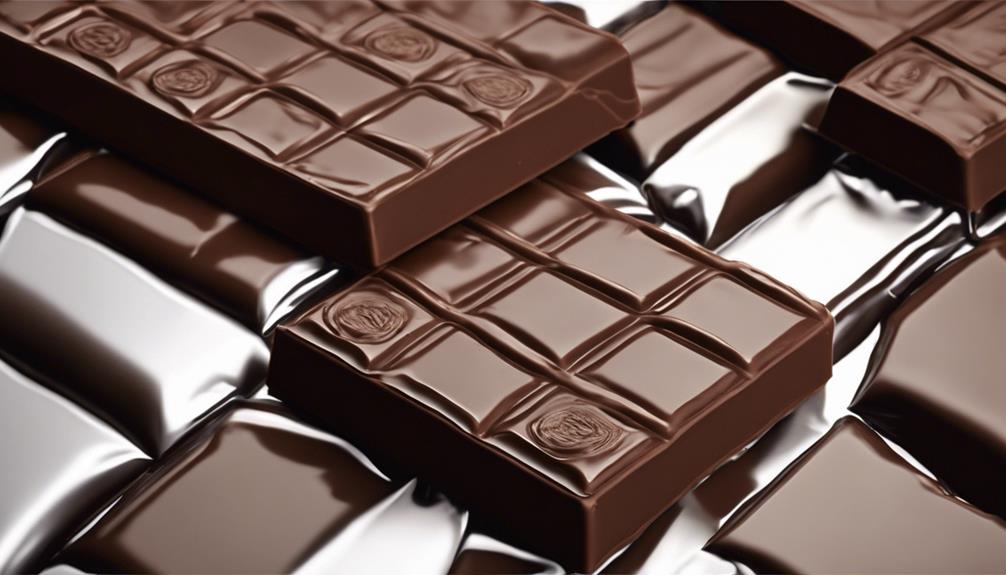
Comparing tempered and untempered chocolate, the difference in appearance is striking: one boasts a smooth, glossy finish while the other appears dull and lacks the enticing shine of its tempered counterpart. Here's why the appearance of tempered chocolate stands out from untempered chocolate:
- Professional Finish: Tempered chocolate presents a professional and polished look due to its smooth and shiny surface.
- Dullness of Untempered Chocolate: Untempered chocolate lacks the luster and glossiness that make tempered chocolate visually appealing.
- Bloom Effect: Untempered chocolate often develops white streaks or spots called bloom, giving it a blotchy appearance that's absent in tempered chocolate.
- Visually Pleasing Sheen: Tempered chocolate sets with a visually pleasing sheen that enhances its overall attractiveness, while untempered chocolate appears lackluster in comparison.
Understanding these differences in appearance can help you appreciate the visual appeal that tempered chocolate brings to confectionery and dessert creations.
Texture: Snap Vs Softness
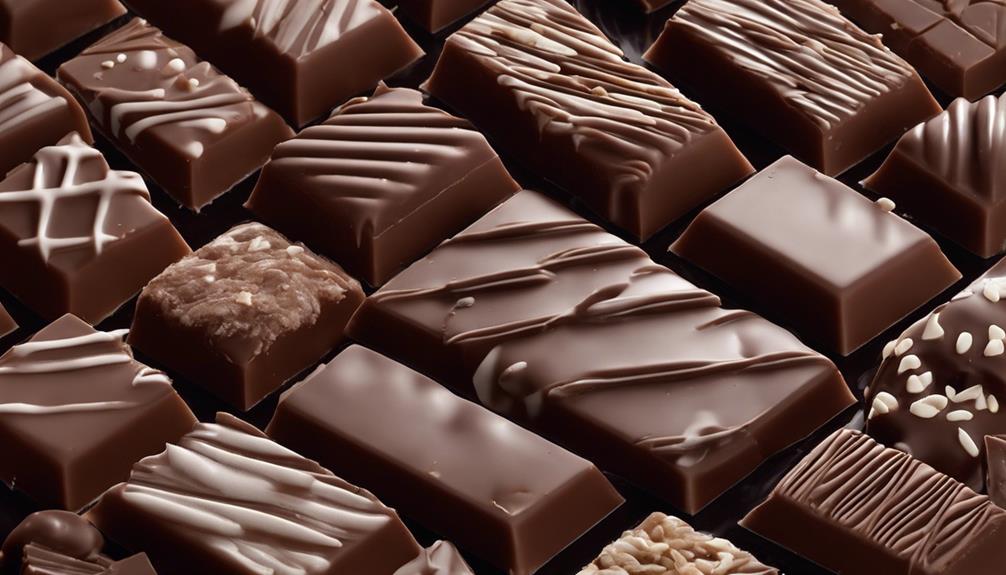
With tempered chocolate, you can feel a satisfying snap when breaking it due to its firm texture. Tempered chocolate has a smooth and glossy texture that enhances the overall eating experience. On the other hand, untempered chocolate tends to have a soft and chalky mouthfeel, lacking the satisfying snap characteristic of tempered chocolate. The firmness of tempered chocolate is what gives it that delightful snap when you break it, creating a more enjoyable sensory experience.
To better understand the differences between tempered and untempered chocolate, let's compare their textures in the table below:
| Texture | Tempered Chocolate | Untempered Chocolate |
|---|---|---|
| Firmness | Firm and Snappy | Soft and Chalky |
| Mouthfeel | Smooth and Glossy | Soft and Melts Easily |
| Breakability | Satisfying Snap | Lacks Snap |
| Melting | Resists Melting | Melts Easily |
| Eating Experience | Enhanced | Less Satisfying |
Stability at Room Temperature
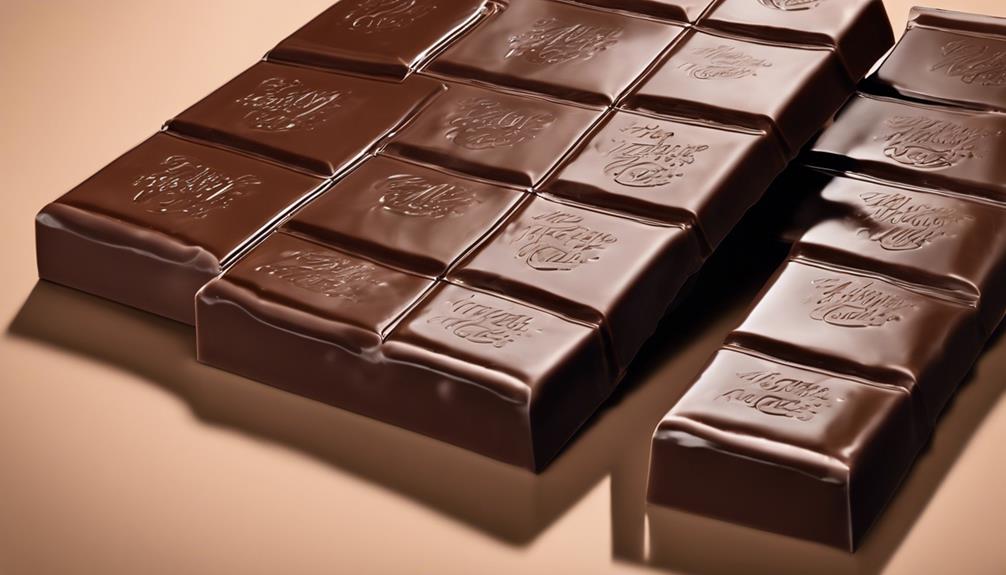
Shifting from the discussion on texture, the stability of chocolate at room temperature is a critical aspect that distinguishes tempered and untempered chocolate. When you leave tempered chocolate out, it stays firm and solid, maintaining its shape and texture without succumbing to the warmth of the room. Untempered chocolate, on the other hand, quickly softens and begins to melt when exposed to room temperature, causing it to lose its form and glossy appearance.
Here are four key points to keep in mind:
- Tempered chocolate remains firm and stable at room temperature, retaining its original shape and luster.
- Untempered chocolate is prone to softening and melting swiftly in room temperature conditions.
- The stability of tempered chocolate guarantees a more professional presentation for a longer time.
- Properly tempered chocolate has a higher resistance to heat and humidity, making it perfect for a variety of culinary applications.
Understanding these differences can help you appreciate the importance of tempering chocolate for the best stability at room temperature.
Melting Resistance
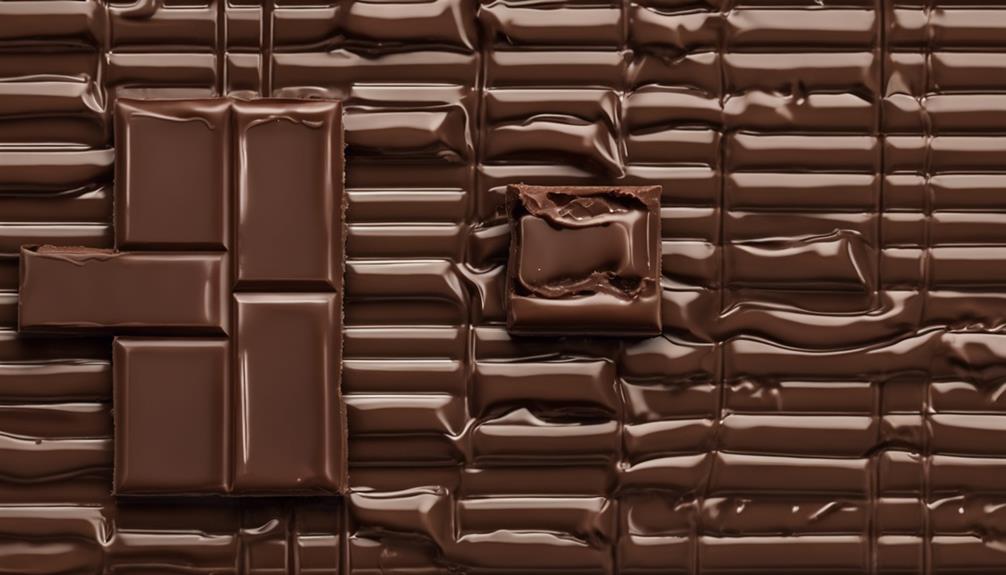
Tempered chocolate's higher melting point sets it apart from untempered chocolate, ensuring greater resistance to heat-induced melting. When we talk about melting resistance, tempered chocolate stands strong against warm temperatures due to its stable crystal structure. On the other hand, untempered chocolate, with its unstable crystal structure, quickly succumbs to heat and loses its form. To illustrate the difference more clearly, let's compare the melting resistance of tempered and untempered chocolate in the table below:
| Property | Tempered Chocolate | Untempered Chocolate |
|---|---|---|
| Melting Resistance | Higher melting point, resistant to heat-induced melting | Lower melting point, easily melts in warm conditions |
| Crystal Structure | Stable crystal structure | Unstable crystal structure |
| Form Integrity | Maintains shape and structure in warm environments | Quickly turns soft and loses form when exposed to heat |
Ideal Uses: Coating and Molding
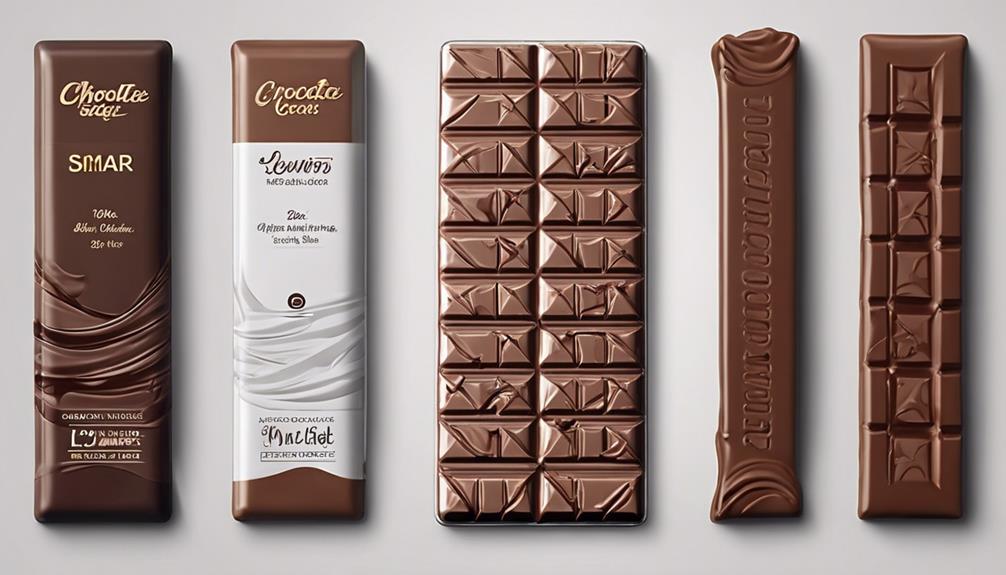
For coating truffles and molding chocolate shapes, tempered chocolate's glossy finish and firm texture make it the ideal choice.
- Smooth Coating: Temper chocolate before coating fruits, nuts, or confections to achieve a smooth, professional appearance.
- Defined Details: When molding intricate chocolate shapes, using tempered chocolate guarantees a clean release and sharp, defined details.
- Enhanced Presentation: The shiny, attractive finish of tempered chocolate on coated items enhances the overall presentation, making them visually appealing.
- Stability and Durability: The firm texture of tempered chocolate provides stability and durability, essential for both coating and molding processes.
Tempered chocolate's glossy finish not only adds a professional touch to your creations but also ensures that your coated items look inviting and appetizing. By using tempered chocolate for coating and molding, you ensure that your final products will have a polished and elegant appearance.
Glossy Finish
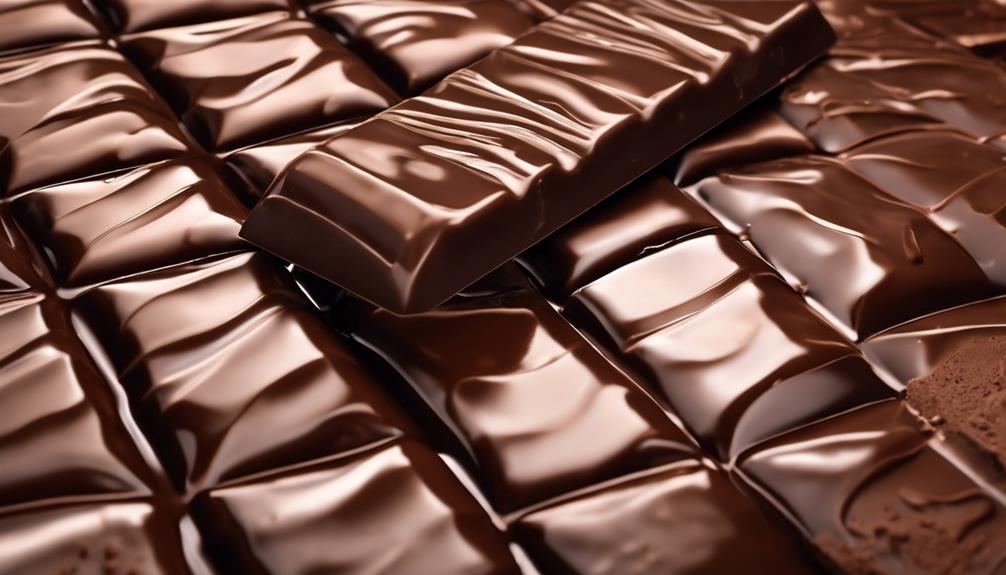
When comparing tempered and untempered chocolate, one noticeable difference is the glossy finish.
Tempered chocolate shines brilliantly due to the proper alignment of cocoa butter crystals.
In contrast, untempered chocolate often lacks this shine, appearing dull and uneven in texture.
Appearance Comparison
In comparing tempered and untempered chocolate, the glossy finish plays an essential role in determining the overall quality and visual appeal of the final product. When looking at appearance differences between the two:
- Tempered chocolate showcases a shiny and reflective surface that beautifully captures light, enhancing its luxurious look.
- Untempered chocolate, on the other hand, lacks this glossy finish, appearing dull or matte, which may not be visually appealing.
- The smooth and reflective nature of tempered chocolate gives it a professional and polished appearance, indicating skillful craftsmanship.
- Conversely, untempered chocolate might present a rough or blotchy surface, lacking the finesse and elegance associated with properly tempered chocolate.
Texture Analysis
Achieving a glossy finish on chocolate involves mastering the art of proper crystallization during the tempering process. When chocolate is tempered correctly, it develops a shiny exterior that reflects light, giving it a professional and appealing look.
In contrast, untempered chocolate lacks this glossy finish, appearing dull and matte in comparison. The smooth and shiny texture of tempered chocolate enhances the overall visual appeal of desserts and confections.
This glossy finish is a clear indicator that the cocoa butter within the chocolate has been tempered well, ensuring stability and a pleasing mouthfeel. So, next time you're working with chocolate, remember that proper crystallization is the key to achieving that beautiful glossy finish that makes your treats irresistible.
Impact on Taste
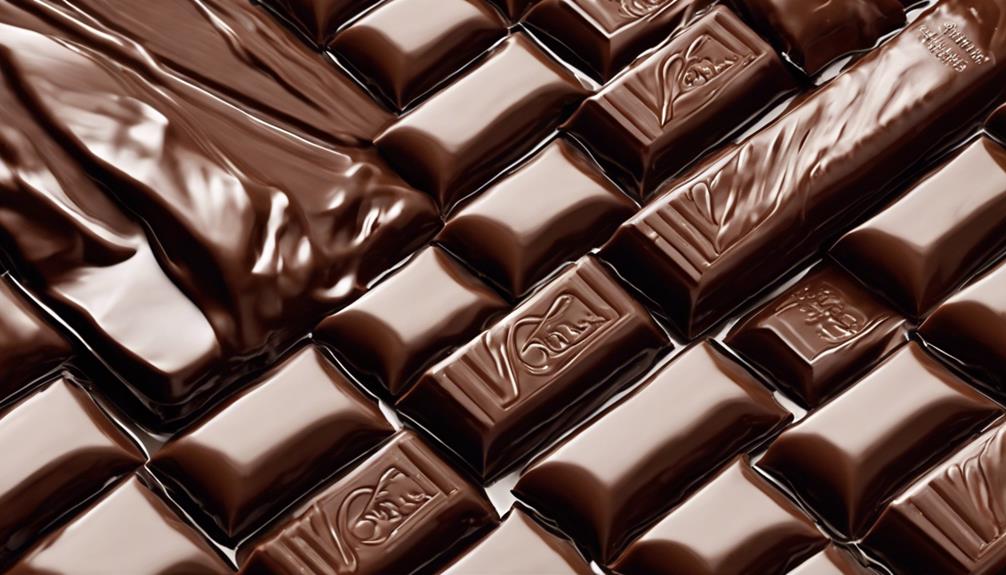
Experiencing the taste of tempered chocolate versus untempered chocolate reveals a stark contrast in flavor quality and texture satisfaction.
- Tempered chocolate has a smoother mouthfeel, melting effortlessly on the tongue, allowing the flavors to unfold gradually.
- Untempered chocolate, on the other hand, can feel gritty and chalky in the mouth, detracting from the overall taste experience.
- The flavor of tempered chocolate is cleaner and more pronounced, as the proper crystallization process guarantees a well-balanced taste profile.
- Untempered chocolate may taste inconsistent, with some parts overly sweet while others lack depth, due to the improper texture and structure.
Importance of Tempering
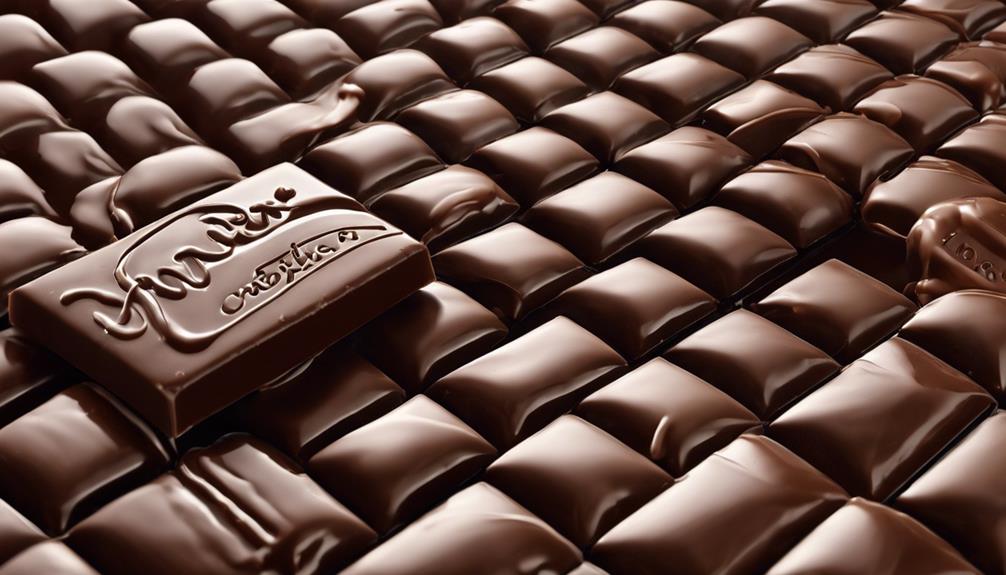
Shifting from discussing the impact of tempered versus untempered chocolate on taste, it becomes evident that understanding the importance of tempering chocolate is fundamental for achieving desirable texture and appearance in the final product.
When we talk about tempering chocolate, we're actually referring to a process that guarantees the right type of crystals form within the chocolate. These crystals are vital because they help give chocolate its signature glossy finish and that satisfying snap when you break it. Without proper tempering, chocolate can become dull-looking, soft, or even grainy in texture, which mightn't be what you're aiming for in your culinary creations.
By aligning the fatty acid crystals through tempering, we create a smooth texture that's consistent throughout the chocolate. This smoothness is what allows us to mold, coat, and create beautiful decorations with chocolate.
Frequently Asked Questions
What Are the 3 Characteristics of Tempered Chocolate?
When it comes to tempered chocolate, three key characteristics stand out: it hardens to a glossy finish, sets quickly for a satisfying snap, and offers a smooth mouthfeel. These traits make it a favorite for professional chocolate creations.
What Is the Difference Between Tempered and Untempered Chocolate Strawberries?
When it comes to chocolate-covered strawberries, the key difference between tempered and untempered versions lies in their appearance, texture, and shelf life. Tempered strawberries boast a glossy finish, satisfying snap, and longer-lasting quality compared to untempered ones.
Does Untempered Chocolate Taste Different?
Untempered chocolate tastes different from tempered chocolate. It lacks the smooth texture and glossy finish. The mouthfeel is softer and chalkier. The unstable crystalline structure makes it melt easily. The overall experience is less satisfying.
What Is the Difference Between Melting and Tempering Chocolate?
Melting chocolate turns it liquid, while tempering involves precise heating and cooling for a glossy finish. Tempered chocolate stays firm at room temp, unlike melted. A key difference is texture—tempered choc offers a satisfying snap.
What is the Role of Cocoa Butter in Tempered and Untempered Chocolate?
Cocoa butter plays a crucial role in tempered and untempered chocolate. In tempered chocolate, it helps create a smooth and glossy finish, while in untempered chocolate, it forms a softer texture. The benefits of cocoa butter extend to enhancing flavor, providing a creamy mouthfeel, and improving the chocolate’s shelf life.
Conclusion
To wrap up, comprehending the disparities between tempered and untempered chocolate is vital for achieving the perfect texture, appearance, and stability in your chocolate creations.
By tempering your chocolate properly, you can guarantee a smooth, glossy finish with a satisfying snap and enhanced taste.
So next time you're making chocolate treats, remember the significance of tempering to elevate your creations to the next level.
Don't settle for less than the best – temper your chocolate for delicious results!
Rachael, the Editor in Chief of RachaelsRawFood.com, is an inspiring and passionate individual who has dedicated her life to promoting the benefits of a raw food lifestyle. Known for her vibrant and energetic personality, Rachael has built a strong online presence that has transformed her personal journey into a thriving community of raw food enthusiasts.
Raw Food Ingredients
Flapjack Vs Pancake Vs Hotcake: a Detailed Culinary Comparison
Fascinated by flapjacks, pancakes, and hotcakes? Uncover the secrets behind these breakfast staples in a detailed culinary comparison.
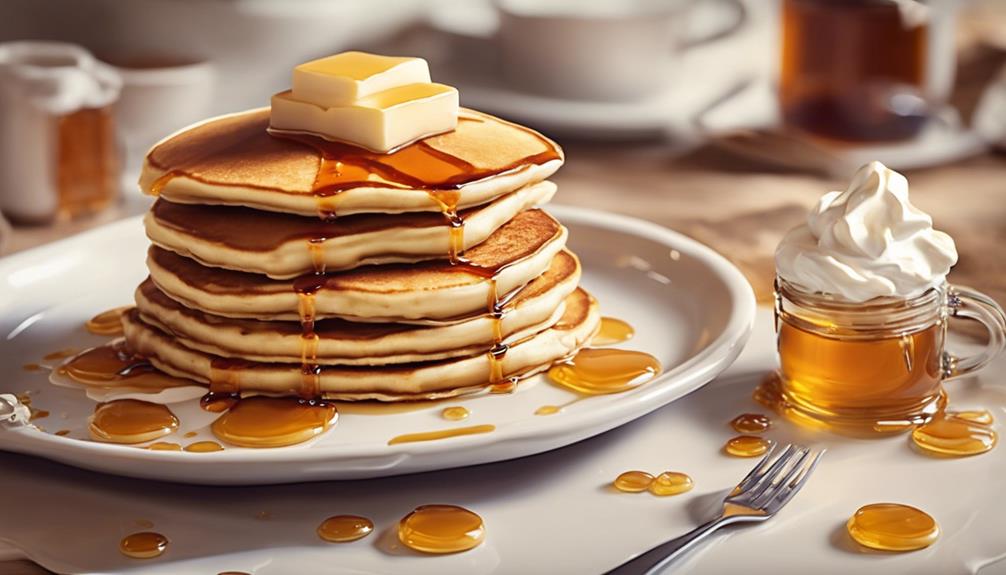
When comparing flapjacks, pancakes, and hotcakes, it’s evident that each offers distinct textures, flavors, and influences from different regions. Flapjacks, which date back to the late 1500s, use oats and brown sugar for a chewy sweetness, while pancakes, a global favorite for centuries, consist of flour, eggs, milk, and butter for a fluffy versatility. Hotcakes, thick and heavy with various flavors like chocolate or syrup, cater to different preferences. Understanding the unique ingredients, textures, and cooking methods of these breakfast treats will unveil a world of culinary diversity and delicious possibilities.
Key Takeaways
- Flapjacks use oats and brown sugar for a chewy, sweet taste.
- Pancakes have a fluffy texture with flour, eggs, milk, and butter.
- Hotcakes are thick and heavy, offering a substantial bite.
- Each type caters to different preferences in texture and consistency.
- Unique regional variations influence ingredients, flavors, and cooking methods.
Origins and History
The history of flapjacks, pancakes, and hotcakes reveals intriguing cultural and regional culinary distinctions. Flapjacks, often referred to as griddle cakes, have a long and rich history, with the term originating in the late 1500s to describe a type of pancake. In the UK, flapjacks are distinct from traditional pancakes, as they're made from rolled oats, butter, and golden syrup, offering a heartier texture and flavor profile.
On the other hand, pancakes have been a staple in global culinary traditions for centuries, known by various regional names and prepared using diverse ingredients.
The versatility of griddle cakes, flapjacks, or pancakes is evident in their adaptability to different cultural preferences and regional availability of ingredients. Whether you prefer the oat-based flapjacks of the UK or the classic pancake variations found worldwide, these beloved treats continue to bring joy to breakfast tables across the globe.
Ingredients and Flavor Profiles
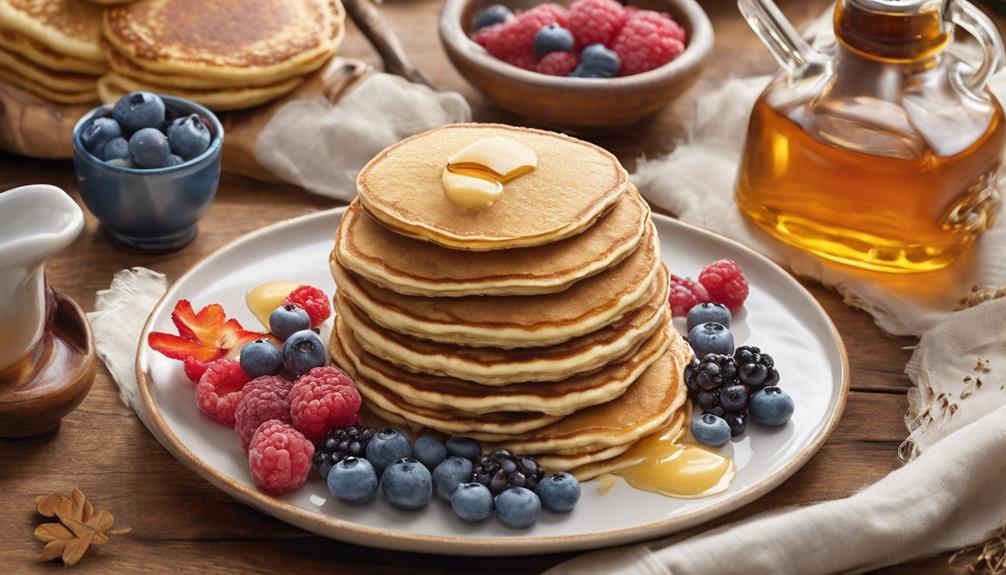
When making flapjacks, the key ingredients like rolled oats and brown sugar give them a chewy and sweet taste.
Pancakes, on the other hand, use a batter of flour, eggs, milk, and butter for a fluffy and versatile flavor.
Hotcakes may vary in texture and can be flavored with chocolate or syrup for a richer taste experience.
Ingredients Breakdown
Comparing the ingredients breakdown of flapjacks, pancakes, and hotcakes reveals distinct textures and flavors unique to each variation. Flapjacks in the UK are crafted from oats and brown sugar, resulting in a chewy and hearty texture that sets them apart.
On the other hand, pancakes typically comprise flour, eggs, milk, and butter, yielding a light and fluffy consistency that many enjoy.
Hotcakes, known for being denser and thicker than traditional pancakes, offer a more substantial bite due to their specific ingredients.
The flavor profiles of flapjacks, pancakes, and hotcakes vary based on regional recipes and the distinct ingredients used in each. Each variant, whether it's flapjacks, pancakes, or hotcakes, provides a one-of-a-kind taste experience shaped by the precise ingredients employed.
Flavor Contrasts
In exploring the flavor contrasts of flapjacks, pancakes, and hotcakes, one immediately notices the distinctive ingredients that shape their unique taste profiles.
When it comes to pancakes, the classic combination of flour, eggs, milk, and butter creates a light and fluffy texture with a neutral taste.
On the other hand, flapjacks stand out with their hearty and slightly sweet flavor, thanks to ingredients like rolled oats and brown sugar.
Hotcakes offer a denser texture and richer flavor compared to traditional pancakes, making them a favorite among those who prefer a pivotal breakfast option.
The use of different ingredients like oats, spices, or sweeteners plays an essential role in creating these delicious flavor variations on the griddle.
Texture and Consistency
As a pancake enthusiast, I appreciate the distinct variations in texture and consistency among flapjacks, pancakes, and hotcakes. When it comes to pancakes, they are typically made with a batter that is cooked on one side, resulting in a soft and fluffy texture that melts in your mouth. On the other hand, flapjacks offer a denser and chewier experience, thanks to ingredients like oats that give them a hearty and robust consistency. Hotcakes, known for being thicker and heavier than the other two, provide a more substantial bite that some may prefer for a more filling meal.
To help you visualize the differences better, here's a comparison table:
| Texture | Consistency | |
|---|---|---|
| Pancakes | Soft and fluffy | Light |
| Flapjacks | Dense and chewy | Hearty and robust |
| Hotcakes | Thick and heavy | Substantial |
Each type offers a unique texture and consistency, catering to various preferences among pancake lovers.
Cooking Methods and Techniques
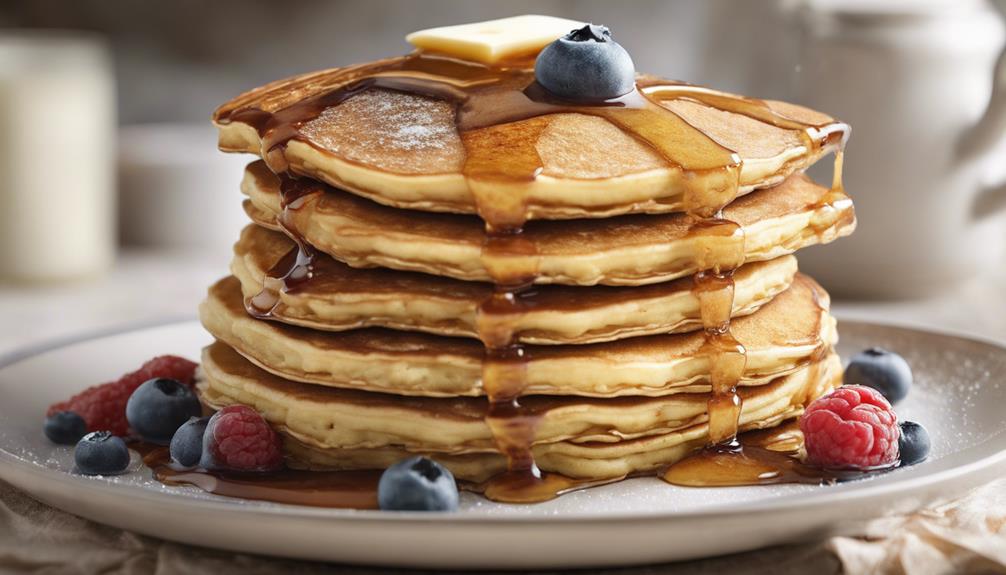
When exploring the cooking methods and techniques for flapjacks, pancakes, hotcakes, and griddlecakes, one can observe unique regional variations that influence the preparation process.
- Batter: The batter for these delightful treats is a key component. It's typically made from a mixture of flour, eggs, milk, and butter. This batter is then poured onto a hot griddle or flat surface to cook.
- Griddle: The cooking surface plays an essential role in achieving the perfect flapjack, pancake, hotcake, or griddlecake. Whether it's a traditional griddle, frying pan, or flat surface, the heat must be evenly distributed to ensure uniform cooking.
- Syrup: Once these delicious creations are cooked to golden perfection, they're often served with a generous drizzle of syrup. Whether it's maple syrup, honey, or fruit compote, the choice of syrup adds a delightful sweetness to the dish.
Mastering the art of cooking these breakfast delights involves understanding the batter consistency, managing the griddle's heat, and choosing the perfect syrup for that finishing touch.
Regional Variations and Traditions
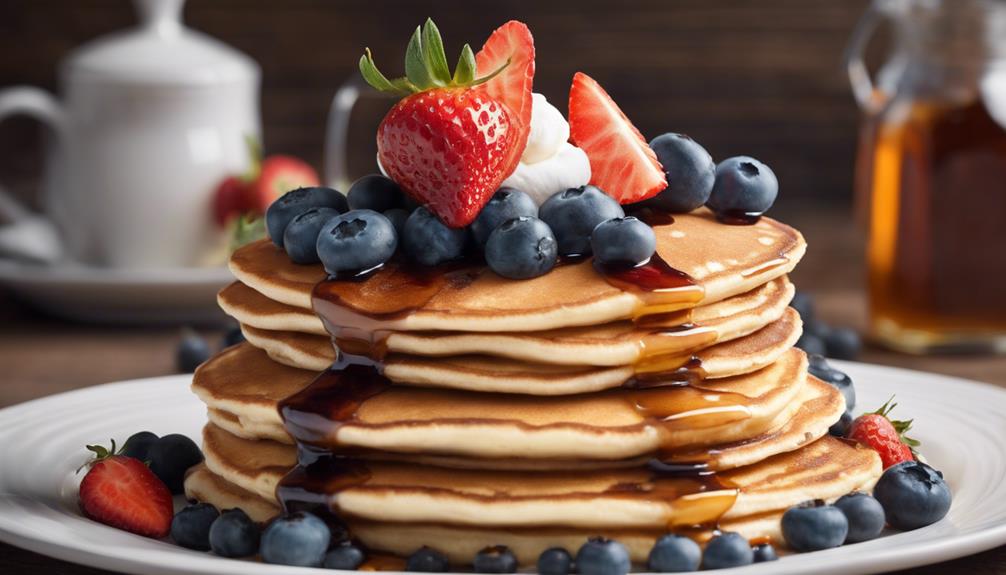
When it comes to pancakes, each region has its own unique twist on this beloved breakfast food. African pancakes like injera, canjeero, and lahoh showcase the diverse pancake variations found across the continent.
From South African pannekoek with cinnamon sugar to Chinese pancakes served with duck, regional traditions and flavors add a rich tapestry to the world of pancakes.
Cultural Pancake Differences
Exploring cultural pancake differences reveals a rich tapestry of flavors and traditions from around the world. African pancakes, such as injera, canjeero, and lahoh, each offer unique ingredients and flavors.
South African pannekoek is commonly served with cinnamon sugar, a traditional topping that adds sweetness to the dish. Chinese pancakes, typically made with dough, are often enjoyed with duck or as a snack.
Indian pancakes showcase regional diversity with varieties like cheela in North India and dosa in South India, highlighting different cooking methods and flavors.
Southeast Asian countries present unique pancake variations like Indonesian serabi and Filipino salukara, reflecting diverse cultural influences in their cuisine.
Flapjack Regions Worldwide
Flapjack regions worldwide showcase a diverse array of regional variations and traditions, each offering a unique twist on this beloved oat-based treat.
In the UK, flapjacks are baked oats bars made with oats, butter, and syrup, distinct from American pancakes.
Australian flapjacks are sweet and chewy bars, combining oats, golden syrup, and butter for a delightful treat.
American flapjacks, often called pancakes, differ from UK flapjacks but share similarities with South African thin pancakes served with syrup or jam.
The term 'flapjack' varies in meaning across regions, encompassing a range of food items from baked oat bars to traditional pancakes. Each region puts its own spin on flapjacks, creating a delightful culinary adventure for those who savor these tasty treats.
Hotcake Traditions Around Globe
Continuing our exploration of hotcake traditions around the globe, we encounter a rich tapestry of regional variations and culinary customs that highlight the diverse ways in which these beloved pancakes are enjoyed worldwide.
In Japan, hotcakes are famous for their exceptional thickness and fluffiness, achieved by vigorously beating the batter until foamy.
Indonesian serabi offers a unique twist with its one-sided pancake, featuring distinct burn marks from clay pan cooking.
Meanwhile, Scottish drop scones stand out by incorporating cream of tartar into the batter, creating a specific flavor profile that sets them apart from traditional flapjacks.
Each region's take on hotcakes adds a special touch to this universally loved breakfast treat.
Popular Toppings and Accompaniments
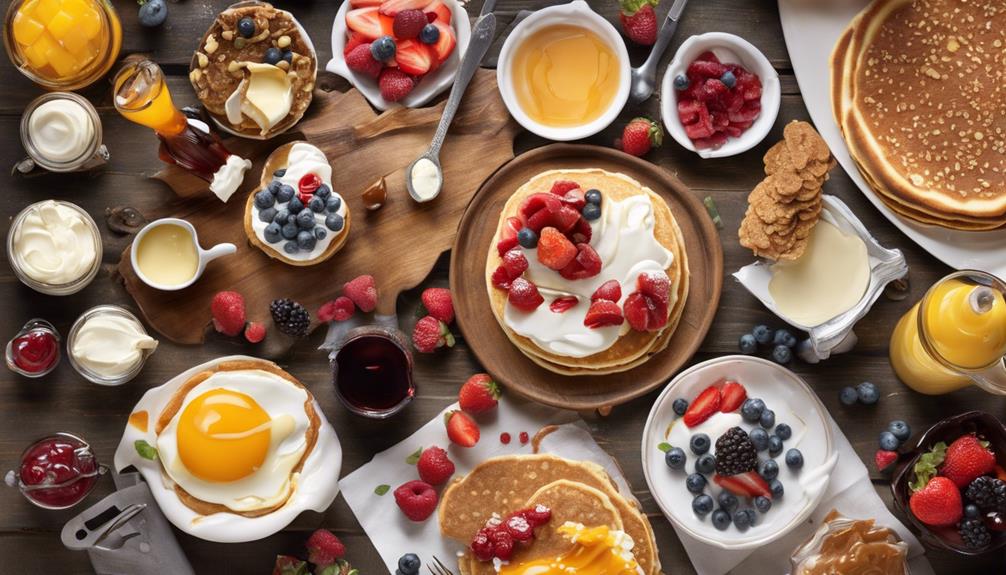
When it comes to pancakes, flapjacks, and hotcakes, a variety of popular toppings and accompaniments can enhance the flavors and experience of these griddle cakes. Maple syrup is a classic choice, drizzled generously over the warm stack, while melting butter adds a rich and creamy touch. Fresh fruits like strawberries, blueberries, or bananas can bring a burst of sweetness and a pop of color to your breakfast. For those with a sweet tooth, chocolate chips sprinkled on top create a decadent treat that's hard to resist.
To complement these griddle cakes, consider serving them with crispy bacon, savory sausage, eggs cooked to your liking, or golden hash browns for a hearty and satisfying meal. If you're in the mood for something different, try adding savory toppings like cheese, ham, or vegetables for a unique twist. For a touch of indulgence, experiment with accompaniments such as peanut butter, Nutella, yogurt, or nuts to elevate the flavors and textures.
And for those seeking a sweet and luxurious option, specialty toppings like lemon curd, honey, jam, or caramel sauce offer a delightful finishing touch to your pancakes, flapjacks, or hotcakes.
Frequently Asked Questions
What Is the Difference Between Hotcakes Pancakes and Flapjacks?
I'll explain the difference between hotcakes, pancakes, and flapjacks. Each term generally refers to a similar griddled treat, but slight variations exist in thickness and regional usage. Let's explore these distinctions together.
Why Do Americans Call Pancakes Flapjacks?
I call pancakes flapjacks because of historical usage and cultural influences. It's a fun, informal term that adds a cozy vibe to breakfast. Plus, it's a nod to tradition and a way to make the morning meal feel special.
What Country Calls Pancakes Flapjacks?
I'm aware that in the US and Canada, some regions informally call pancakes "flapjacks." It's interesting how terminology can vary across countries. It's always fascinating to learn about these nuances in culinary customs.
Do British People Call Pancakes Hotcakes?
No, British people typically do not call pancakes hotcakes. In Britain, we commonly refer to this dish simply as pancakes. The term 'hotcakes' is more commonly used in American English rather than in British culinary culture.
How Do Hotcakes Differ from Flapjacks and Pancakes?
Hotcakes, also known as pancakes, are typically thinner and fluffier than flapjacks, which are a bit denser and chewier. Flapjacks are also often made with oats or other grains, while hotcakes are more commonly made with a simple batter of flour, eggs, and milk. Hotcakes explained here.
Conclusion
To sum up, flapjacks, pancakes, and hotcakes each have unique origins, ingredients, and cooking methods. Whether you prefer the fluffy texture of pancakes, the denser consistency of flapjacks, or the slightly sweet flavor of hotcakes, there's something for everyone to enjoy.
Next time you're in the mood for a delicious breakfast treat, why not try making all three and see which one becomes your new favorite?
Rachael, the Editor in Chief of RachaelsRawFood.com, is an inspiring and passionate individual who has dedicated her life to promoting the benefits of a raw food lifestyle. Known for her vibrant and energetic personality, Rachael has built a strong online presence that has transformed her personal journey into a thriving community of raw food enthusiasts.
Raw Food Ingredients
The Essence of a Cocoa Ceremony
Sip from the cup of ancient wisdom and embark on a transformative journey through the spiritual essence of a Cocoa Ceremony.

The heart of a Cocoa Ceremony is rooted in its ancient origins and healing qualities. Emerging from Central and South America, this ceremonial tradition utilizes ceremonial-grade cocoa for therapeutic and spiritual purposes, helping individuals connect with deep wisdom and overall well-being benefits. Through participation in a Cocoa Ceremony, one welcomes transformative experiences that access ancient wisdom, fostering emotional release, clarity, intuition, and gratitude. To learn more about the spiritual importance, preparation procedures, and introspective reflections associated with a Cocoa Ceremony, delve into additional information on this captivating practice.
Key Takeaways
- Cocoa Ceremony embodies ancient wisdom and healing properties.
- It promotes emotional release, forgiveness, and heightened awareness.
- Ceremonial cacao enhances self-awareness and emotional balance.
- The ceremony involves setting intentions, reflection, and gratitude.
- Closing rituals honor the sacred connection with cacao and the transformative experience.
Origins of Cocoa Ceremony
In Central and South America, the practice of Cocoa Ceremony has its origins for both medicinal and ceremonial purposes. Ceremonial Cacao, as it's known, holds a significant place in spiritual practices. Ancient Mesoamerican cultures valued Cocoa not only for its health benefits but also for its spiritual significance. Shamans and healers would use ceremonial-grade cocoa in rituals to connect with the spirit world, seeking healing and guidance. This tradition has been passed down through generations and is now integrated into modern wellness programs.
The preparation of ceremonial cocoa is a sacred process. It involves grinding cocoa beans and mixing them with water, cacao butter, sweeteners, and spices like cayenne pepper and cinnamon. The resulting drink isn't just a beverage but a conduit for spiritual connection and healing. Ceremonial-grade cocoa is rich in antioxidants, magnesium, iron, fiber, and compounds that can enhance mood. Embracing the origins of Cocoa Ceremony allows us to tap into ancient wisdom and experience the profound benefits of this sacred practice.
Spiritual Significance of Ceremonial Cacao
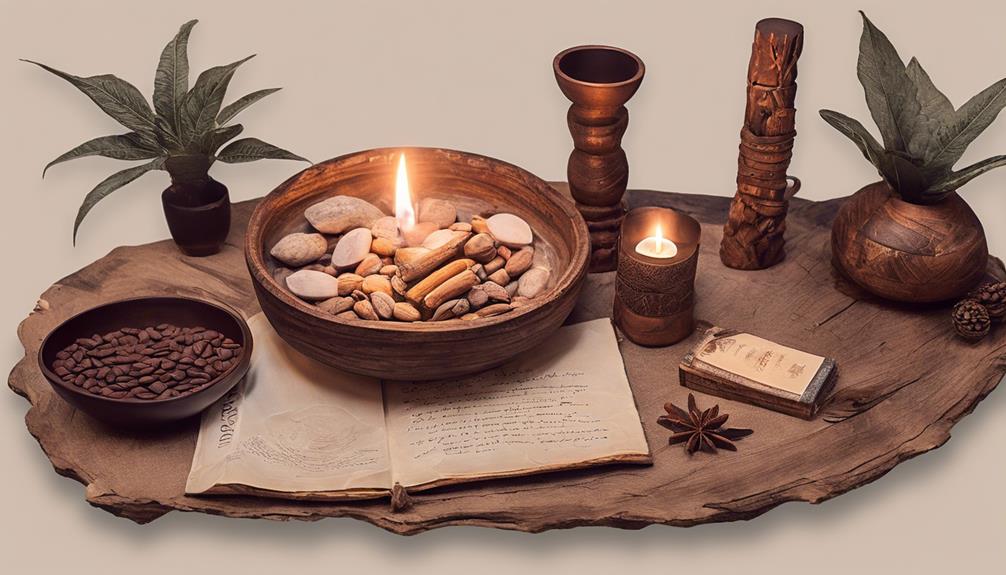
Exploring the spiritual domain, ceremonial cacao embodies ancient wisdom and healing properties, revered by indigenous cultures for its sacred and feminine essence. The Spirit of Cacao is believed to reside within this sacred plant, guiding individuals towards inner reflection and connection with the divine. Below is a table that illustrates the spiritual significance of ceremonial cacao:
| Aspect | Significance |
|---|---|
| Sacred Rituals | Used in ceremonies for births, marriages, and battles, symbolizing unity and spiritual protection. |
| Healing Properties | Believed to offer physical, emotional, and spiritual healing, promoting overall well-being. |
| Connection to Self | Facilitates introspection, helping individuals explore deeper into their innermost thoughts and emotions. |
Embracing ceremonial cacao in a space of reverence allows one to tap into the profound energies it holds. By honoring the spirit of the cacao plant, we open ourselves to its transformative powers, fostering a deeper connection to our true selves and the world around us.
Benefits of Engaging in a Cocoa Ceremony
Engaging in a cocoa ceremony reveals a pathway to emotional release and forgiveness among participants. As we gather together and sip on the sacred cacao elixir, we enter a meditative state that allows us to let go of pent-up emotions and grudges. The cacao's energy works wonders, helping us release what no longer serves us and opening our hearts to forgiveness. Through this process, we create a space for healing and understanding, fostering a deep sense of emotional release that can be truly transformative.
In addition to emotional benefits, engaging in a cocoa ceremony can also lead us to a heightened state of clarity and intuition. The cacao's properties help quiet the mind and enhance our ability to tune into our inner wisdom, guiding us towards a better understanding of ourselves and our surroundings. This heightened awareness can bring about a sense of gratitude and connection, allowing us to experience heart-opening moments that leave a lasting impact on our lives.
Steps to Prepare for a Cocoa Ceremony
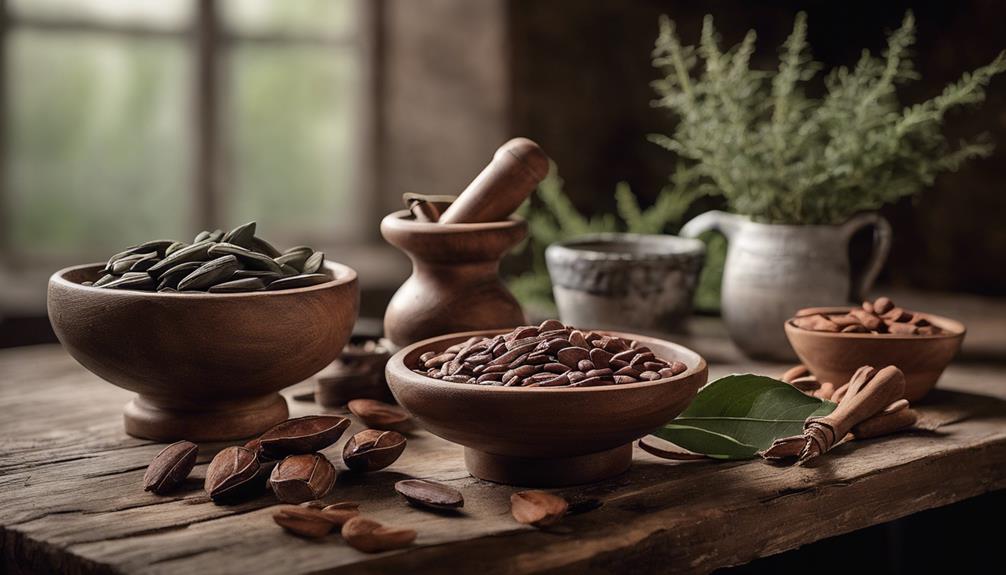
To prepare for a Cocoa Ceremony, start by gathering ceremonial-grade cacao, known for its purity and quality.
Set a clear intention for the ceremony to guide your experience and create a sacred space with meaningful items and symbols.
Mindfully prepare the ceremonial cacao, focusing on the process and energy, before engaging in meditative practices, reflection, and community sharing during the ceremony.
Ritual Significance Explained
In preparing for a Cocoa Ceremony, the initial step involves gathering ceremonial-grade cacao, cacao butter, water, sweetener, and spices like cayenne pepper and cinnamon.
Creating a sacred space is vital to set the right ambiance for the ceremony. This space should be peaceful, allowing for a serene and focused atmosphere.
Setting a clear intention for the ceremony is essential as it guides the energy and purpose of the gathering. Beginning with an opening that expresses gratitude and intention helps to establish the tone for the ritual.
As the ceremony concludes, it's important to ground the energy, express gratitude, and formally close the sacred space to honor the experience. These steps are integral to the ritual significance of the Cocoa Ceremony.
Gathering Ceremonial Ingredients
When preparing for a Cocoa Ceremony, the final step involves sourcing ceremonial-grade cacao from reputable suppliers known for quality and authenticity.
To enhance the ceremonial experience, it's essential to gather organic sweeteners like raw honey or maple syrup to complement the cacao's flavor.
Additionally, preparing sacred herbs or spices such as cinnamon, cayenne pepper, or cardamom can elevate the richness of the ceremony.
Lastly, incorporating high-quality ceremonial-grade cacao butter adds depth to the ceremonial drink.
Setting Sacred Intentions With Cocoa
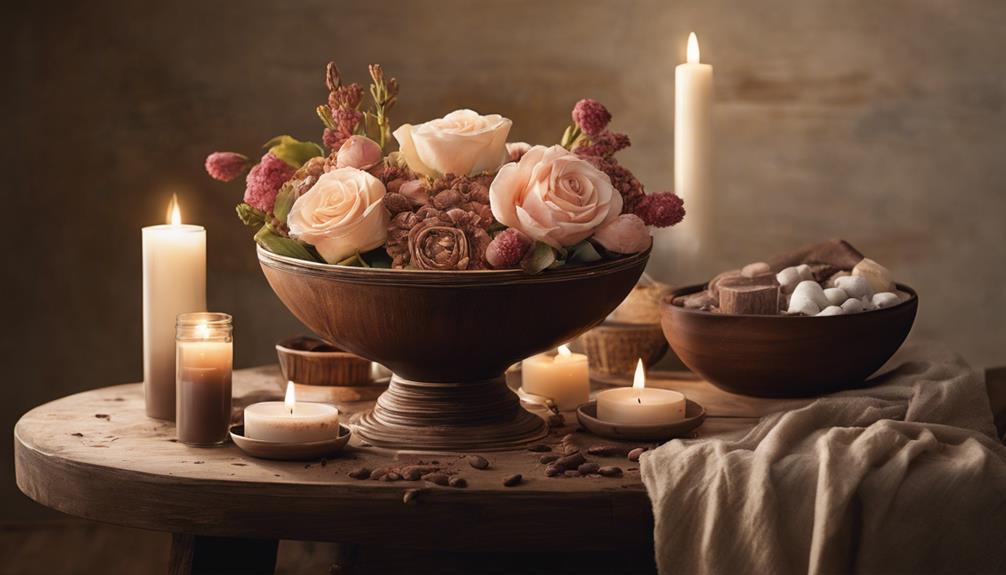
Setting sacred intentions with cocoa is a powerful practice that involves infusing this sacred plant with our heartfelt desires. By expressing our intentions clearly and sincerely, we invite the spirit of cocoa to work with us in a ritualistic manner.
This intentional act sets the stage for a transformative and profound experience during the cocoa ceremony.
Sacred Intentions Explanation
How can one infuse their energy and focus with specific goals or desires during a cacao ceremony by setting sacred intentions?
Setting sacred intentions in a cacao ceremony is a powerful practice that allows you to align your energy and attention towards your deepest desires. Here's how you can do it effectively:
- Focus your mind: Clear your thoughts and concentrate on what truly matters to you.
- Visualize your intentions: Picture your goals as if they've already come to fruition.
- Speak your intentions aloud: Verbally express your desires to the universe and the spirit of cacao.
- Feel the emotions: Connect with the emotions associated with achieving your intentions to amplify their manifestation power.
Ritualistic Cocoa Practice
To immerse oneself fully in the practice of setting sacred intentions with cocoa, one must approach the ritual with a focused mind and a clear vision of their goals and desires. The sacred plant of cacao holds immense power to assist in this process.
By setting sacred intentions, one establishes a profound connection with the spirit of cacao, inviting its wisdom and energy into the ceremonial space. This intentional act serves as a guiding light, directing the flow of the ceremony towards personal growth and healing.
Each intention acts as a beacon, illuminating the path towards transformation and spiritual insight. Embrace the ritualistic cocoa practice with reverence and openness, allowing the essence of cacao to infuse your intentions with its magic.
Enhancing Self-Connection Through Cocoa

Enhancing self-connection through cocoa involves engaging in intentional rituals and practices focused on deepening self-awareness. When I sip ceremonial-grade cocoa, it opens my heart, allowing me to truly connect with myself on a deeper level. Here are four ways cocoa can enhance self-connection:
- Mood Enhancement: The compounds in ceremonial-grade cocoa can uplift my spirits and help me feel more emotionally balanced.
- Antioxidant Benefits: By consuming cocoa rich in antioxidants, I support my emotional well-being and overall health.
- Introspection: Through meditations and reflections during a cocoa ceremony, I can explore my inner thoughts and emotions.
- Personal Growth: Practicing gratitude, setting intentions, and embracing reciprocity during a cocoa ceremony can lead to profound self-discovery and growth.
Enhancing self-connection through cocoa is a beautiful journey of self-exploration and growth. By incorporating these practices into my cocoa ceremonies, I can deepen my relationship with myself and foster a greater sense of well-being.
Ritual Practices During a Cocoa Ceremony
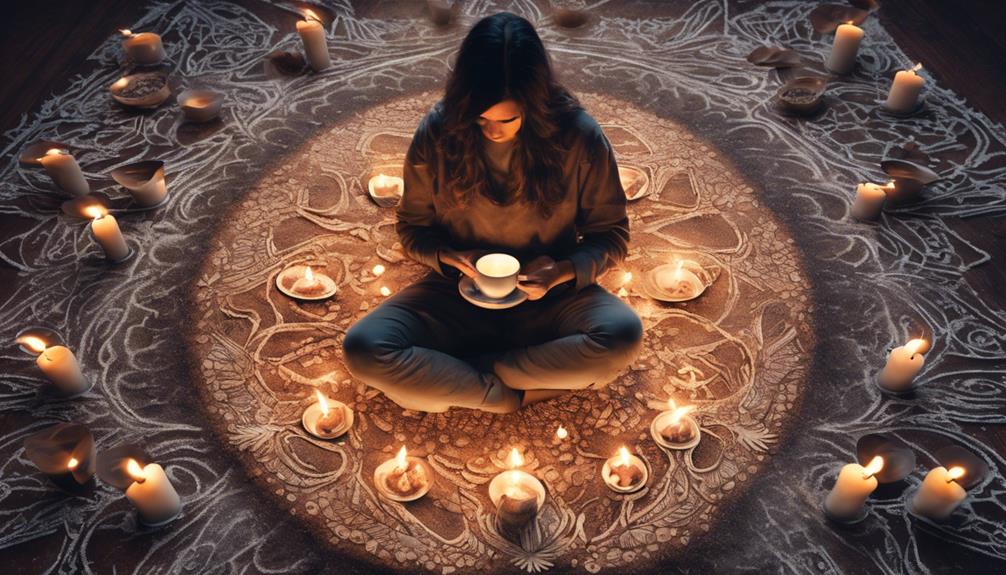
Engaging in a cocoa ceremony involves honoring ancient traditions and fostering heart-centered connections through ritual practices. One of the key aspects of a cocoa ceremony is the act of setting intentions. This practice involves focusing on what you hope to gain from the ceremony, whether it be introspection, healing, or emotional release. By setting intentions, participants create a guiding purpose for their experience, allowing them to fully immerse themselves in the ritual.
During a cocoa ceremony, individuals engage in various activities that promote heart-centered connections. This includes meditation, reflection, and sharing with the community. These practices help to deepen the sense of connection not only with others but also with oneself and the spirit of cacao. Ceremonial-grade cacao is used in these rituals to honor the ancient Mesoamerican traditions that recognized the spiritual significance of cacao, further enhancing the sense of communal connection and reverence for the ceremony.
| Ritual Practice | Description |
|---|---|
| Setting Intentions | Focusing on desired outcomes |
| Heart-Centered Connections | Engaging in meditation, reflection, and community sharing |
Closing and Reflecting on the Cocoa Experience
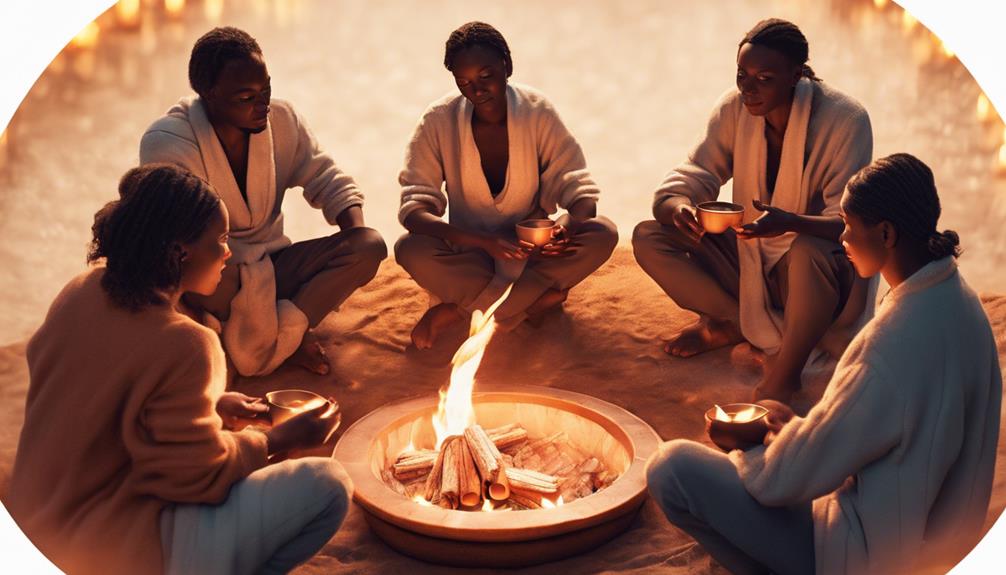
Reflecting on the cacao experience serves as an important step in integrating the insights gained during the ceremony. As we close the cacao ceremony, it's essential to take time to reflect on the impact of this sacred ritual. Here are four key aspects to contemplate during this reflective process:
- Integration of Insights: Reflect on the emotions, thoughts, and visions that arose during the ceremony. Ponder how these experiences can be applied to your daily life.
- Grounding and Shifting: Use closing rituals to ground yourself and shift back to everyday life. Take deep breaths, feel your connection to the earth, and express gratitude for the experience.
- Sharing Experiences: Open up and share your experiences and insights with others present. This act of sharing can deepen the communal bond and offer different perspectives on the ceremony.
- Understanding Impact: Reflect on how ceremonial cacao consumption has affected your emotional and spiritual well-being. Acknowledge any shifts or revelations that have occurred within you.
Closing a cacao ceremony with gratitude and reverence honors the sacred connection with cacao and the transformative experience it provides.
Frequently Asked Questions
What Is the Point of a Cacao Ceremony?
The point of a cacao ceremony is to connect deeply with the spirit of cacao, set intentions, and experience its transformative powers. It's all about honoring the sacred attributes of cacao, seeking spiritual connection, and living from the heart.
What Is the Spiritual Meaning of Ceremonial Cacao?
The spiritual meaning of ceremonial cacao lies in its ability to foster deep connections, honor traditions, and facilitate emotional healing. It invites introspection, mindfulness, and a heightened sense of spiritual awareness and connection.
What Does Cacao Do to Your Body?
Cacao invigorates my body by boosting circulation and providing essential nutrients. It speaks to my emotions, empowering my heart and renewing my spirit. Cacao offers healing, soothing, or creative energy, depending on my intention and dosage.
What Is the Healing Ritual of Cacao?
The healing ritual of cacao? It's like a warm hug for my soul, melting away worries and opening my heart to the universe's whispers. Cacao's magic brings peace, clarity, and a deeper connection within.
Can I Use Ceremonial Cacao for a Cocoa Ceremony?
Yes, you can use ceremonial cacao for a cocoa ceremony. The ceremonial cacao recipe steps are essential to follow for an authentic experience. From selecting the right cacao to preparing it with intention, each step contributes to the sacred nature of the ceremony.
Conclusion
To sum up, the cocoa ceremony is a sacred practice with deep roots in ancient traditions. By participating in this ritual, we can connect with ourselves on a spiritual level and set intentions for personal growth.
The benefits of this ceremony go beyond just the physical, offering a unique opportunity for self-reflection and inner exploration. Consider incorporating a cocoa ceremony into your routine to enhance your connection with yourself and the world around you.
Rachael, the Editor in Chief of RachaelsRawFood.com, is an inspiring and passionate individual who has dedicated her life to promoting the benefits of a raw food lifestyle. Known for her vibrant and energetic personality, Rachael has built a strong online presence that has transformed her personal journey into a thriving community of raw food enthusiasts.
-

 Raw Food Ingredients1 month ago
Raw Food Ingredients1 month agoHow To Make Hot Chocolate With Raw Cacao Powder
-

 Raw Food Ingredients1 month ago
Raw Food Ingredients1 month agoHow To Make Chocolate From Raw Cacao
-

 Raw Food Ingredients1 month ago
Raw Food Ingredients1 month agoHow To Prepare Raw Cacao Drink
-

 Raw Food Ingredients1 month ago
Raw Food Ingredients1 month agoHow Much Raw Cacao Per Day For Full Benefits
-
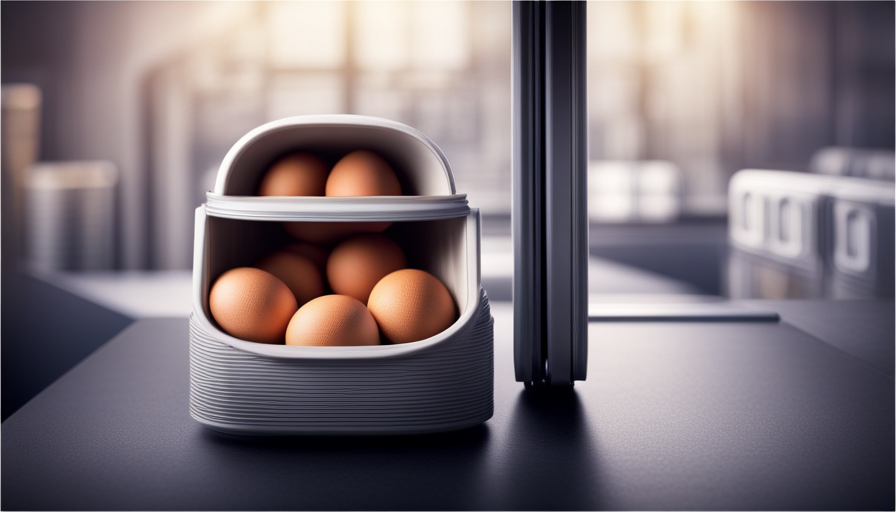
 What is Raw Food?2 months ago
What is Raw Food?2 months agoHow Long Should Uncooked Food With Raw Egg Be In The Refrigerator
-

 Raw Food Ingredients1 week ago
Raw Food Ingredients1 week agoRaw Cacao Powder How Much For 8 Oz Hot Chocolate Recipe
-

 Raw Food Ingredients1 month ago
Raw Food Ingredients1 month agoWhen Fasting Can I Drink Coffee With Raw Cacao Powder
-

 Raw Food Ingredients1 month ago
Raw Food Ingredients1 month agoHow Much Caffeine Is In Raw Cacao Powder







